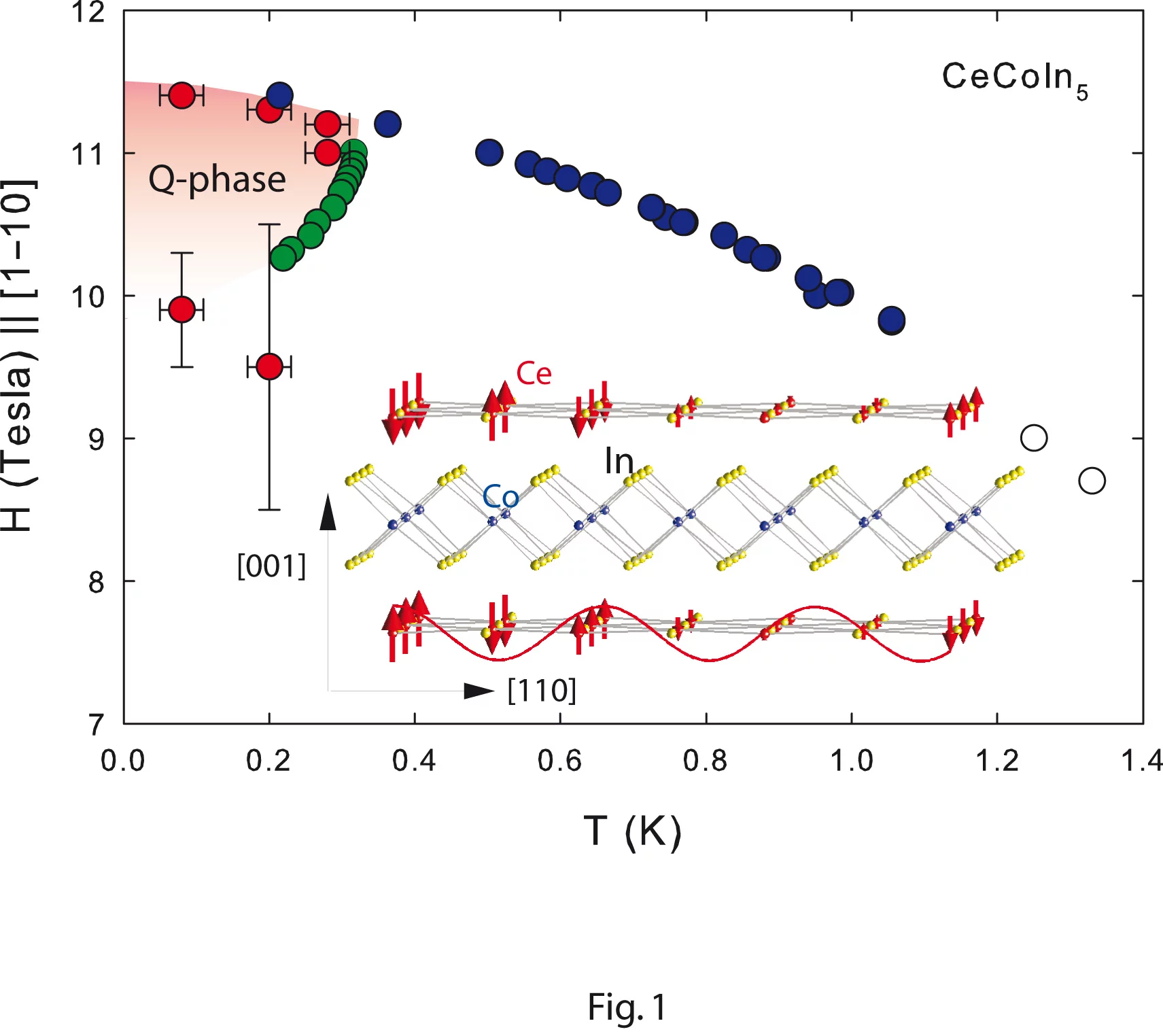From rivals to partners
The wild world of quantum mechanics produces states that are not predicted by the classical theory of physics.Today's edition of Science magazine includes a report of an astonishingly new type of state by an internationalteam of scientists around physicist Michel Kenzelmann from the Paul Scherrer Institute in Switzerland.
The experiments were carried out at the Swiss Spallation Neutron Source (SINQ) at the Paul Scherrer Institute (PSI). The SINQ neutron beam can be used to investigate the internal properties of materials without their destruction. This method allows the observation of processes that are not visible by any other means.
Coupled superconductivity and magnetism in Cerium-Cobalt-Indium
The research team achieved a surprising breakthrough. They discovered that the investigated material, Cerium-Cobalt-Indium, can become magnetically ordered, but only if it is at the same time also superconducting. This discovery is particularly astounding, since these two phenomena usually compete. In Cerium-Cobalt-Indium, however, magnetic order can apparently only exist if the material is superconducting.
Interaction between magnetism and superconductivity
In electrical conductors, electric current is carried by electrons. This leads to a loss of energy as soon as electrons collide with the positive crystal ions in the conductors, deflecting them from their optimum path. The loss-free transportation of electricity in superconductors is based on the fact that electrons join up to form so-called Cooper pairs
. Such electron pairs have completely different characteristics from individual electrons and behave entirely differently; they switch to a new quantum state. This state allows the Cooper pairs to talk to each other
in order to avoid collisions. This is what makes it possible to transport electricity without any losses.
Electrons possess a magnetic moment, which can be pictured as a kind of compass needle. In a Cooper pair, the compass needles
of the two electrons usually point exactly into opposing directions, thus cancelling out their magnetic effect. When a superconducting state is subject to a magnetic field, the magnetic moments of the electron pairs become disturbed. On the one hand, this happens because the magnetic field induces currents that break the Cooper pairs apart. On the other hand, this happens because the magnetic field disturbs the opposing alignment of the magnetic moments in a Cooper pair. If the magnetic field succeeds in inducing magnetism to a Cooper pair, the Cooper pair is broken up and superconductivity is lost. In many materials, therefore, magnetism and superconductivity compete.
According to Kenzelmann, scientist at PSI and professor at ETH Zurich, magnetism and superconductivity do not always exclude each other, but they only tolerate each other at the very most. Superconductivity and magnetism behave like two rivals who compete for the same territory: they try limit or suppress the presence of their opponent.
Superconducting induces magnetism
In their experiment, the researchers cooled a crystal made up of the elements cerium, cobalt and indium (CeCoIn5) to minus 273.1 degrees Celsius. All the atomic movements in the crystal cease at such low temperatures, and the electrons that are travelling through the material can join together to form Cooper pairs. This produces the superconducting electrical state, which makes it possible to transport the electricity without any loss of power.
The researchers discovered that a new type of superconducting state came about when high magnetic fields were applied. This was accompanied by magnetism, and was not destroyed by it. Although the coexistence of magnetism and superconductivity had already been observed in other cases, the new aspect of this cerium compound lies in the fact that the magnetism only appears during the superconducting phase, and disappears abruptly with the superconductivity at even higher magnetic fields. This surprising observation suggests that magnetism is driven and stabilised by superconductivity in this particular case.
Our results show clearly that superconductivity is absolutely vital for this magnetism to occur. This study will help us to understand more clearly how the electron pairs form in magnetic superconductors in the first place. We hope that the information can then be used for technological applications in the future
, explained Prof. Kenzelmann.
Contact
Prof. Dr. Michel Kenzelmann
Laboratory of Developments and Methods
PSI
+41 56 310 53 81
michel.kenzelmann@psi.ch
Original publication
-
Kenzelmann M, Strässle T, Niedermayer C, Sigrist M, Padmanabhan B, Zolliker M, et al.
Coupled superconducting and magnetic order in CeCoIn5
Science. 2008; 321(5896): 1652-1654. https://doi.org/10.1126/science.1161818
DORA PSI
About PSI
The Paul Scherrer Institute PSI develops, builds and operates large, complex research facilities and makes them available to the national and international research community. The institute's own key research priorities are in the fields of future technologies, energy and climate, health innovation and fundamentals of nature. PSI is committed to the training of future generations. Therefore about one quarter of our staff are post-docs, post-graduates or apprentices. Altogether PSI employs 2300 people, thus being the largest research institute in Switzerland. The annual budget amounts to approximately CHF 450 million. PSI is part of the ETH Domain, with the other members being the two Swiss Federal Institutes of Technology, ETH Zurich and EPFL Lausanne, as well as Eawag (Swiss Federal Institute of Aquatic Science and Technology), Empa (Swiss Federal Laboratories for Materials Science and Technology) and WSL (Swiss Federal Institute for Forest, Snow and Landscape Research). (Last updated in June 2025)

